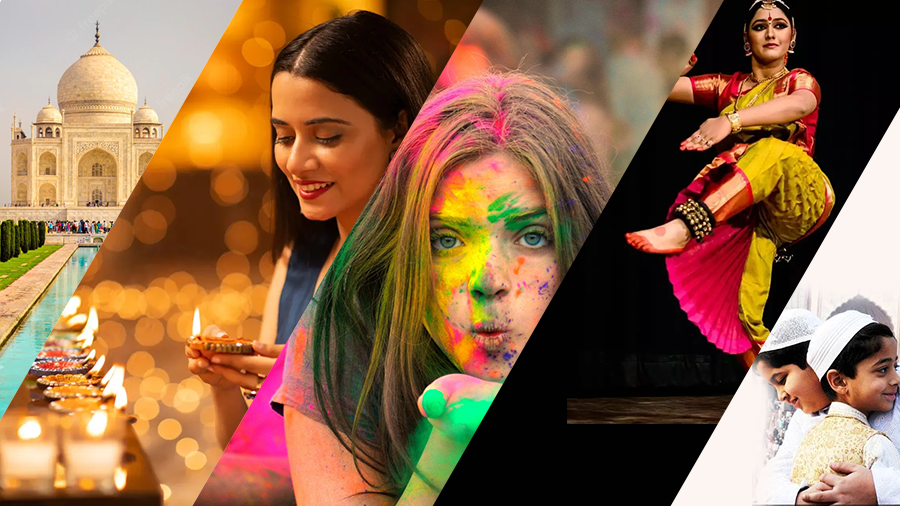
Celebrating Secularism: How India Balances Diverse Beliefs
- admin
- July 22, 2025
- Uncategorized
- 0 Comments
New Delhi, India, 2025 — In a world often divided by religious strife, India stands out as a nation that has woven secularism into its democratic fabric. With over 1.4 billion people practicing a wide spectrum of faiths, from Hinduism, Islam, Christianity, Sikhism, Buddhism, and Jainism to various indigenous traditions, India’s secular ethos fosters peaceful coexistence and inclusivity.
This article delves into how India celebrates secularism, examining its constitutional foundation, practical challenges, and the path forward.
The Constitutional Pillar of Secularism
1. Secularism in the Constitution
India’s secularism is rooted in its Constitution, which guarantees freedom of religion and equality before the law.
- Fact: The 42nd Amendment (1976) explicitly added the word “secular” to the Preamble, emphasizing that the state has no official religion and treats all faiths equally.
- Impact: Articles 25 to 28 of the Constitution ensure the right to religious freedom while maintaining a separation of religion and state in governance.
2. Uniform Civil Code (UCC) Debate
The UCC, proposed to ensure uniform personal laws across all religions, remains a topic of intense debate.
- Fact: As of 2025, states like Goa already implement a version of the UCC, sparking discussions on its nationwide applicability.
- Impact: While the UCC aims to promote equality, critics argue it must balance religious freedoms with constitutional ideals.
How India Balances Religious Diversity
1. Inclusive Governance
India’s commitment to secularism is reflected in policies that ensure representation for all communities.
- Example: Minority-focused initiatives like the Prime Minister’s 15-Point Programme for the Welfare of Minorities provide scholarships, skill development, and improved access to education and employment.
- Data: The program benefited over 12 million students from minority communities in 2024 (Ministry of Minority Affairs).
2. Celebrating Religious Festivals
India embraces its religious diversity through national recognition of multiple festivals.
- Example: Eid, Diwali, Christmas, Guru Nanak Jayanti, and Buddha Purnima are celebrated across the nation, promoting cultural unity.
- Impact: Such celebrations encourage interfaith understanding and foster national integration.
3. Legal Protections for Religious Freedom
India’s judiciary has played a pivotal role in upholding secular principles.
- Example: The Supreme Court’s 2024 ruling upheld the rights of religious minorities to manage their educational institutions autonomously under Article 30.
- Impact: Such decisions reaffirm India’s commitment to safeguarding religious rights.
Challenges to Secularism in Modern India
1. Communal Polarization
Incidents of communal violence and polarizing rhetoric pose challenges to secular harmony.
- Fact: The Election Commission of India (2024) reported a 20% increase in communal rhetoric during electoral campaigns compared to 2019.
- Impact: Such narratives risk deepening societal divides, undermining secular values.
2. Balancing Religious Freedom and Modernization
Efforts to modernize personal laws or practices often clash with traditional religious beliefs.
- Example: The debate over the ban on triple talaq highlighted tensions between gender equality and religious customs.
3. Protection of Marginalized Communities
Religious minorities often face socio-economic disadvantages.
- Data: According to the NITI Aayog (2024), poverty rates among Muslims (31%) and Dalits (34%) remain significantly higher than the national average of 22%.
Lessons from India’s Secular Model
1. Pluralism as Strength
India’s secularism thrives on its ability to accommodate diversity rather than enforce uniformity.
- Example: The coexistence of centuries-old mosques, temples, churches, and gurudwaras reflects India’s inclusive ethos.
2. Institutional Safeguards
Independent institutions like the Election Commission and judiciary ensure that secularism remains central to governance.
- Example: Electoral guidelines prohibit hate speech and the use of religion for electoral gains.
Global Comparisons: Secularism in Practice
1. France’s Laïcité
- Reality: France enforces strict separation of religion and state but faces criticism for restricting religious expression in public spaces.
- Lesson for India: Flexible secularism that accommodates religious diversity can prevent alienation.
2. United States’ Freedom of Religion
- Reality: The U.S. guarantees religious freedom but struggles with the influence of religion on politics.
- Lesson for India: Ensuring state neutrality while protecting religious freedoms is vital.
3. Turkey’s Transition
- Reality: Turkey’s shift from secularism to religion-influenced governance highlights the fragility of secular systems.
- Lesson for India: Vigilance is essential to maintain the balance between religion and state.
Strengthening Secularism in India
1. Promoting Interfaith Dialogue
- Encourage platforms for dialogue to foster understanding among communities.
- Example: Initiatives like the National Foundation for Communal Harmony promote interfaith harmony and peacebuilding.
2. Inclusive Development
- Address socio-economic disparities through targeted welfare programs.
- Recommendation: Expand scholarships and employment schemes for minorities to bridge gaps.
3. Safeguarding Secular Institutions
- Strengthen legal frameworks to prevent hate speech and communal violence.
- Example: Fast-track legislation to penalize religious discrimination in workplaces and educational institutions.
Conclusion: A Celebration of Unity in Diversity
India’s secularism, while not without challenges, remains a powerful testament to the nation’s resilience and inclusivity. By balancing diverse beliefs, promoting equal opportunities, and fostering interfaith harmony, India demonstrates how democracy and secularism can coexist.
As the nation continues to evolve, embracing its pluralistic heritage will ensure that India’s secular fabric remains strong—an example for the world to emulate.


